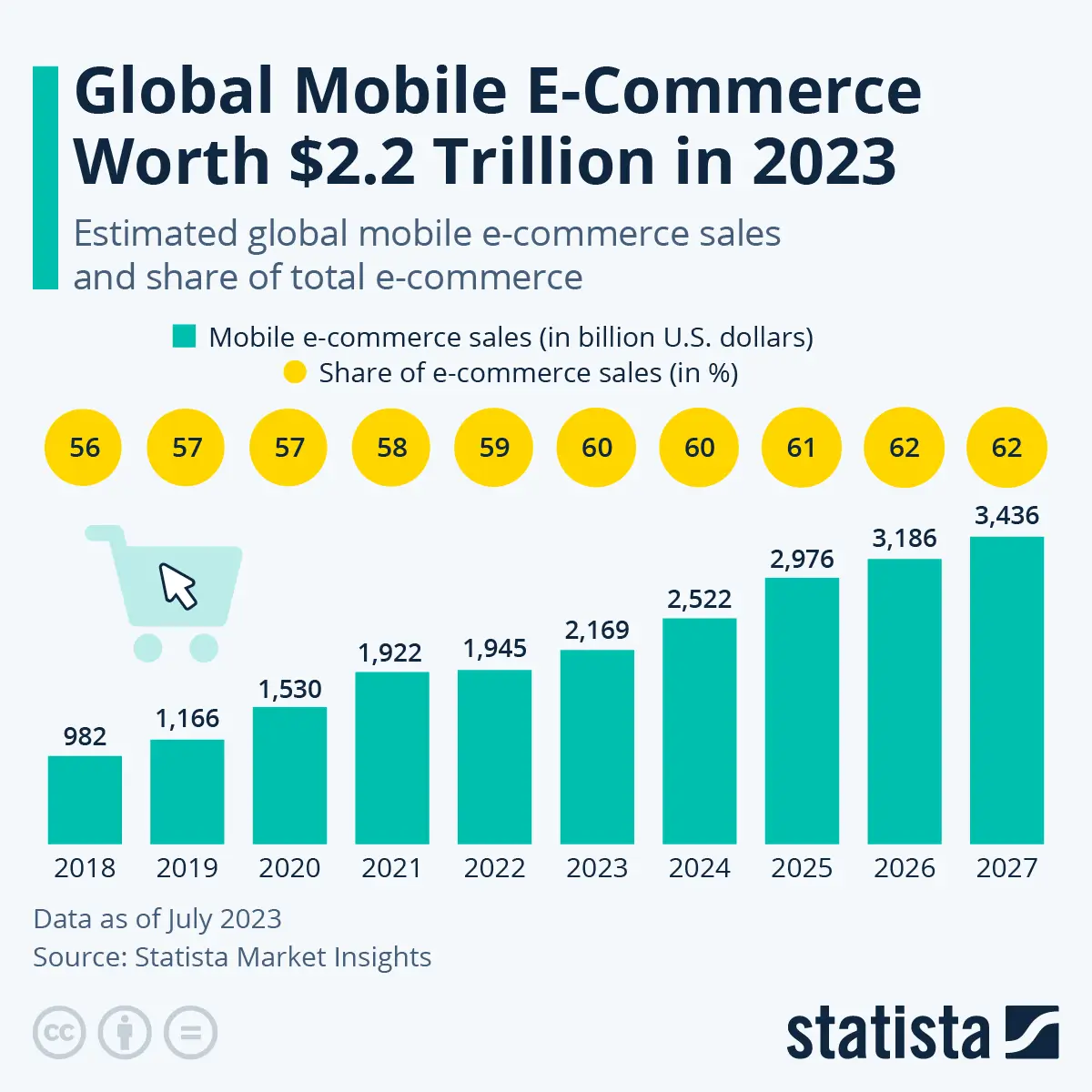
Piyush

As we approach 2024, the future of eCommerce is poised for significant transformations driven by emerging technologies and evolving consumer behaviors. Businesses aiming to stay competitive must anticipate these changes by prioritizing future eCommerce trends such as personalized shopping experiences, seamless integration of online and offline retail, and embracing digital innovations. we’ll explore 15 key trends that are shaping the future of eCommerce and how businesses can leverage these developments to remain competitive.
Table of Contents:
In the constantly changing world of eCommerce, it’s essential to stay updated with upcoming trends that will transform the online shopping experience. These trends, influenced by advanced technology and changing consumer behaviors, are redefining the future of eCommerce. Let’s explore the top 15 future trends changing the ecommerce landscape.
Improving the customer experience is crucial for your brand’s success. The future eCommerce trends will be shaped by advanced technology that helps recreate in-person experiences online. Companies that continuously refine their customer interactions before and after purchases can increase revenue, build customer loyalty, and thrive in the future of eCommerce.
This includes hiring skilled sales staff, carefully reviewing the online sales process, and conducting user testing to ensure that elements such as calls to action, checkout length, required information, messaging, and product page flow align with customer expectations. Continuously refining these aspects will enhance your business’s customer experience.
The future of eCommerce is in omnichannel commerce, which involves seamlessly integrating online and offline channels to offer a unified customer experience. This means removing barriers between sales and communication channels. This approach ensures consistency in inventory management, customer data, and messaging across all platforms.
In today’s market, customers engage with brands through various touchpoints, such as eCommerce sites, mobile apps, social media, and physical stores. To succeed, businesses need to maintain a consistent brand appearance, tone, and quality across these channels. Providing cross-channel customer service is crucial, allowing customers to seek support through their preferred means, whether it’s social media, email, phone, or in-person.
A robust omnichannel strategy also entails gathering and analyzing unified customer data to personalize experiences and enhance service. Businesses that effectively implement omnichannel strategies can enhance customer retention. Research indicates that those with strong omnichannel retailing retain 89% of their customers.
As consumer preferences evolve, businesses must adapt by embracing new channels and technologies to meet customer expectations and remain competitive in the expanding landscape of omnichannel opportunities. Businesses that embrace this future eCommerce trend will see enhanced customer retention and brand loyalty.
Voice-enabled online shopping is on the rise, thanks to the popularity of voice assistants like Amazon Alexa and Google Assistant. Over 50% of Americans use voice search daily, and more than 30% of internet users have employed a voice assistant for shopping. Major retailers such as Amazon, Walmart, and Alibaba have incorporated voice shopping into their platforms, simplifying the process for consumers to browse, compare, and purchase products using only their voice.
As smart home devices become increasingly prevalent, eCommerce businesses are continually enhancing their websites and content for voice search by utilizing natural language processing and conversational AI to deliver fast and accurate responses to voice queries. While the number of voice assistant users in the US has stabilized at around 142 million, integrating voice assistants into more devices and developing new AI-powered features could reignite interest in voice commerce and play a pivotal role in the future of eCommerce.
Augmented Reality (AR) is revolutionizing the future of eCommerce by merging online and offline shopping experiences. It enables customers to interact with products in ways previously only possible in physical stores, offering immersive AR experiences that will become a key differentiator in the world of eCommerce. Brands like Ikea and Sephora have seamlessly integrated AR into their apps, allowing users to virtually place furniture in their homes or test makeup products.
These immersive experiences not only increase customer engagement but also lower return rates as consumers can make more informed decisions. The potential of AR extends beyond these examples, offering broader applications across various retail sectors. As the use of AR continues to expand, it’s poised to become a vital tool in eCommerce, providing a more personalized, interactive, and confident shopping experience.
A well-integrated chatbot reduces the workload of your customer service team, enabling customers to resolve many issues independently and providing 24/7 support. They make it easy to access customer service information and have the potential to improve customer satisfaction. While chatbot interactions used to feel robotic and rigid, recent advances in generative AI have significantly changed how online buyers engage with these tools.
AI-powered assistants can now respond instantly to inquiries, guide product searches, and facilitate transactions with human-like efficiency and empathy. Chatbots not only enhance customer service by providing real-time support and personalized recommendations, but they also help build relationships with customers and foster loyalty for eCommerce businesses. As they continue to evolve, chatbots will play a crucial role in delivering personalized marketing messages, nurturing leads, and driving conversions.
Mobile Shopping is Still on the Move as the era of mobile commerce (m-commerce) continues to dominate the future of eCommerce. According to Statista, mobile eCommerce sales had skyrocketed to an astounding $2.2 trillion, constituting 60% of all eCommerce sales worldwide, with an expected increase to 62% by 2027, powered by the widespread adoption of 5G technology, which enhances digital experiences and enables more captivating content on mobile platforms.

To keep up with this shift, eCommerce businesses need to prioritize mobile optimization. This means ensuring that websites are responsive, load quickly, and are easy to navigate on smaller screens. Moreover, developing dedicated mobile apps can provide a superior user experience, faster performance, and the ability to engage customers through push notifications.
Streamlining the checkout process is also vital, with features such as one-click purchasing and mobile-friendly payment options becoming indispensable. As mobile devices continue to dominate internet traffic, eCommerce companies that embrace mobile-first strategies will be well-positioned to seize the growing market and meet the evolving expectations of consumers, tapping into the growing mobile commerce market, an integral part of the eCommerce future.
Secondhand marketplaces are gaining traction in the eCommerce future due to increased demand for sustainable shopping options. A recent survey in the U.K. found that 44 percent of consumers are buying more secondhand items than last year, with 57 percent regularly shopping for used goods.
While consumer-to-consumer platforms like ThredUp, eBay, and Facebook Marketplace have been dominant, business-to-consumer and business-to-business marketplaces are now becoming major players. Retail giants like Walmart and Lululemon are entering this space, with Walmart introducing B2B liquidation auctions and B2C marketplaces, and Lululemon launching a “Like New” resale website.
These retailers will need to experiment with pricing, logistics, and value chains to ensure profitability. Succeeding in this area will also help them build stronger connections with their target customers by providing more sustainable and affordable purchasing options.
Avoiding shopping cart abandonment is crucial for eCommerce businesses. Losing a potential customer just as they’re about to make a purchase can be frustrating. Many customers abandon their carts because their preferred payment option isn’t available. A complicated checkout process can also deter customers from completing their purchase.
It’s essential to offer a variety of digital payment options to cater to different customer preferences. These may include online banking, Buy Now Pay Later (BNPL) services, digital wallets such as Amazon Pay, Google Pay, PayPal, and Mobilepay, as well as the option to use gift cards and vouchers. Providing popular payment options in your region can significantly improve the checkout experience for your customers.
Attracting customers who commit to making monthly payments is a market that all eCommerce companies aim to tap into. It is challenging to constantly seek new customers. Subscription models have become popular among customers, especially in the beauty and wellness industry.
If you have the right product, enticing customers to purchase subscriptions from your store is not overly difficult. eCommerce businesses need to simplify the payment, product discovery, and delivery process.
Attracting customers who commit to making monthly payments is a market that all eCommerce companies aim to tap into because it is challenging to constantly seek new customers. Subscription models have become popular among customers, especially in the beauty and wellness industry. If you have the right product, enticing customers to purchase subscriptions from your store is not overly difficult.
eCommerce businesses need to simplify the payment, product discovery, and delivery process to adapt to the eCommerce future, which will see a surge in subscription models. This trend comes as businesses focus on retaining customers and simplifying payment processes, making subscriptions an increasingly popular strategy in the future of eCommerce.
Social commerce is shaping the eCommerce future by integrating shopping experiences into social media platforms. This integration enables users to discover, explore, and purchase products without leaving the app. Platforms like Instagram and Facebook have embraced this trend with features such as shoppable posts and in-app purchases, making it easier for users to make purchases. For example, Instagram Shop allows users to tag products in photos and maintain a digital storefront, while TikTok has introduced shopping features like TikTok Shop, enabling brands and creators to sell directly to viewers.
The rise of social commerce is driven by the growing number of social media users, especially among younger demographics like Gen Z. In the United States alone, the number of social media users is projected to exceed 331 million by 2028, offering significant opportunities for businesses to leverage their social media presence, boost sales, and remain competitive in the changing eCommerce landscape.
To succeed in social commerce, businesses must establish a strong social media presence by regularly sharing engaging content, such as product features, customer testimonials, and behind-the-scenes glimpses of the business. Additionally, collaborating with influencers who align with their brand can help businesses reach a larger audience and boost sales. As social media continues to shape consumer behavior, integrating social commerce strategies into eCommerce operations will be crucial for future success. Social commerce not only enhances the shopping experience but also fosters stronger connections with consumers, ultimately increasing sales and boosting brand loyalty.
The easiest way to capture your customers’ attention is to make them interact with you. Quizzes, forms, recommendations, calculators, surveys, assessments, etc., are good examples of interactive content that eCommerce companies must leverage. Not only does it help with increasing engagement, but interactive content can also help you know more about your audience.
Customized loyalty programs are increasingly crucial in the eCommerce market as companies seek to bolster customer connections and improve retention. These programs go beyond traditional point-based systems, providing individualized incentives, exclusive access, and tailored experiences that matter to each customer. Their purpose is to encourage repeat purchases, enhance customer engagement, and cultivate lasting brand loyalty.
To capitalize on this trend, eCommerce businesses can leverage data analytics to categorize customers according to their behaviors and preferences and offer personalized incentives like discounts on frequently purchased items, early access to sales, or special rewards. By integrating loyalty programs across various channels, such as websites, mobile apps, and brick-and-mortar stores, companies can create a cohesive and captivating experience that motivates customers to return.
The use of automation is increasingly crucial for eCommerce businesses as it helps them operate more efficiently by cutting down on manual tasks. Currently, 61% of businesses worldwide utilize automation tools, and this percentage is projected to increase as the advantages become more evident.
Automation encompasses a wide array of functions, from marketing to warehousing. For instance, robotics can be implemented in large warehouses, freeing up employees to concentrate on more strategic aspects of order fulfillment. Moreover, automation in supply chain management can involve software that automatically initiates inventory reordering when stock levels are low.
In general, automation empowers eCommerce businesses to optimize resources, enhance productivity, and focus on innovation. Through thorough research, companies can discover automation tools that streamline operations and propel growth.
AI is transforming eCommerce by enhancing customer experiences, automating operations, and enabling data-driven decision-making. Key technologies such as machine learning, natural language processing, and computer vision empower AI to analyze customer data, recognize patterns, and offer personalized shopping experiences.
AI-powered chatbots and virtual assistants deliver instant, 24/7 customer service, improving engagement and satisfaction. Automation also extends to marketing, where AI optimizes campaigns and tailors content. Additionally, AI simplifies backend operations like inventory management and data security. With AI taking on an increasingly significant role, eCommerce businesses can innovate, boost productivity, and drive sales growth, establishing AI as an essential component of future eCommerce strategies.
The future of eCommerce looks brighter than ever. As the world continues to stabilize post-pandemic, sales have surged, and consumers have returned to their daily routines with renewed enthusiasm. For eCommerce stores, staying updated on the latest industry trends is crucial. Embracing innovative technologies can enhance operations and service delivery, while being responsive to social changes can create new opportunities to connect with your target audience.
If you’re considering incorporating gift cards or loyalty programs into your business strategy, the 99minds team is here to help. Our plug-and-play software is designed to supercharge your business and keep you ahead in this dynamic market.